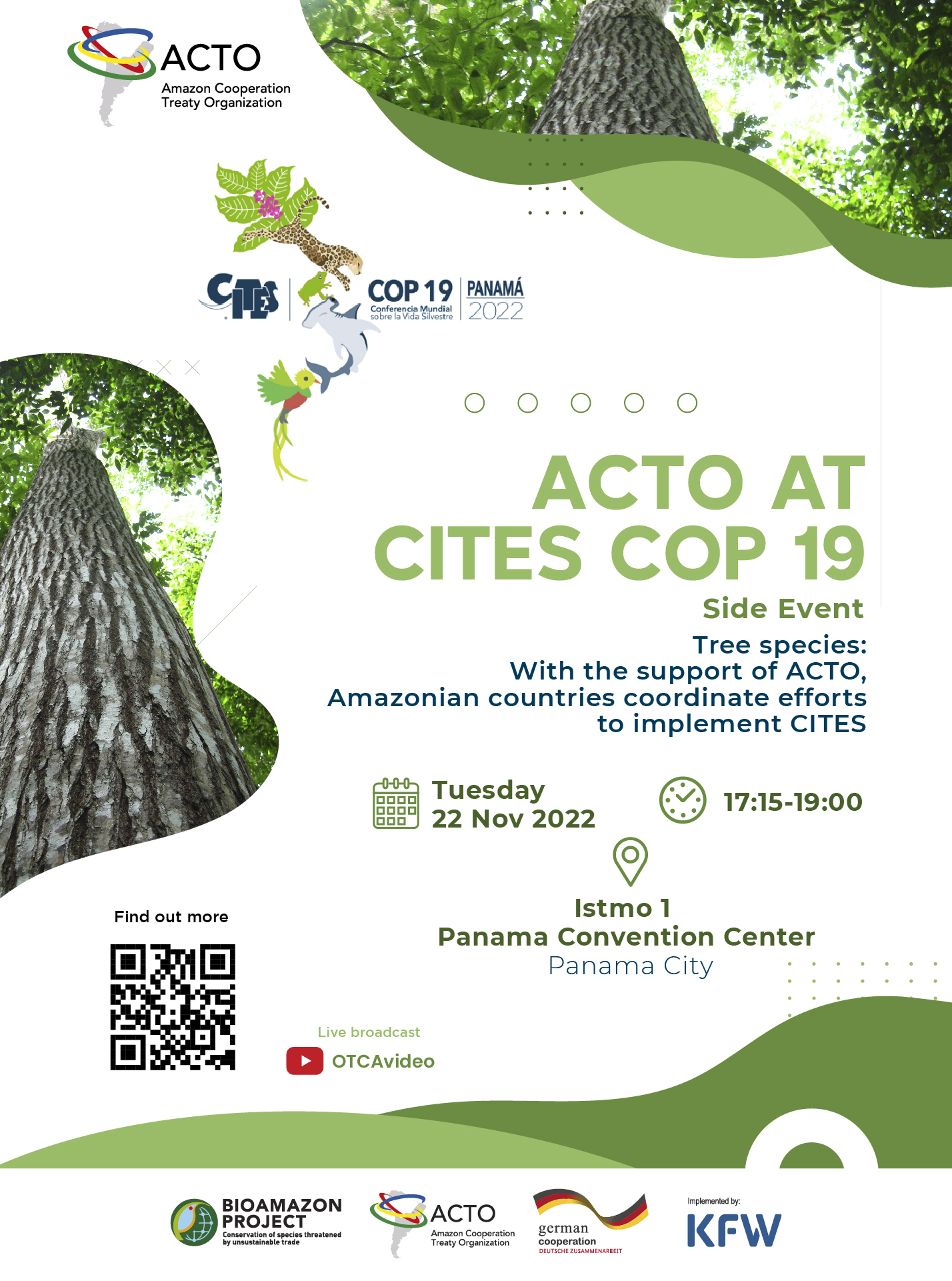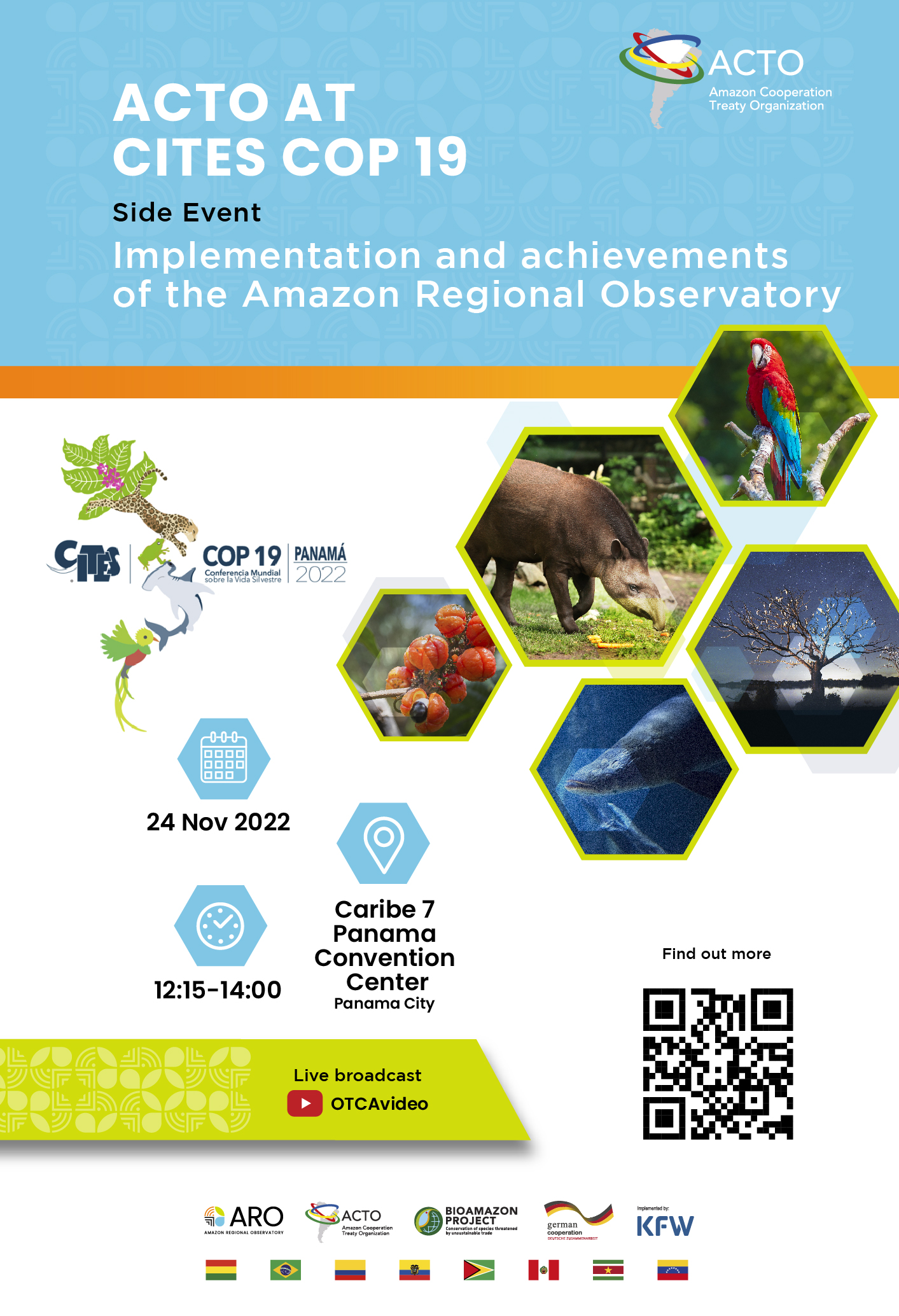ACTO at CITES CoP 19

Nov 09, 2022 | AMAZON REGIONAL OBSERVATORY | ACTO | CoP 19 CITES
In November, the Nineteenth Meeting of the Conference of the Parties to the Convention on International Trade in Endangered Species of Wild Fauna and Flora (CoP 19/CITES) will be held from 14 to 25 November 2022, in Panama City, Panama.
ACTO will participate as an Observer Organization and will hold two parallel events that have been approved by the Convention.
know the programming and Take Part

The event Tree species: Amazonian countries with the support of ACTO coordinate efforts for the implementation of CITES will be held on November 22. The event aims to present the proposal for the Amazonian Regional Action Plan for the implementation of CITES aimed at tree species, as well as to share the experience of ACTO, and of the Member Countries, in the strengthening of the regional governance structure with the participation of CITES Authorities and Forest Authorities.
Launch of the Forest Module of the Amazon Regional Observatory
Speakers
- Mrs. Ivonne Higuero – CITES´General Secretary
- Mr. Carlos Salinas, ACTO´s Administrative Director and Forests Theme Responsible
- Mr. Cesar Beltetón, ACTO/CITES Specialist on the topic Arboreal Species
- Mrs. Fabiola Nuñez, Representative of Peru
- Mr. David Veintimilla, Representative of Ecuador
- Mrs. Kanako Ishii, Representative of the International Tropical Timber Organization (ITTO), on behalf of Mr. Steve Johnson
- Mrs. Margarita África Clemente Muñoz, CITES specialist with extensive experience in tree species
TREE ESPECIES SIDE EVENT PROGRAM

On the 24 November, the side event will be Implementation and results of the Amazon Regional Observatory: effective tools for the Management, Monitoring and Control of Endangered Fauna and Flora Species in the Amazon Region.
This event ambitions to disseminate the Amazon Regional Observatory (ARO) to the international community, along with its objectives, vision and mission, its services and tools for strengthening Amazon information management, -with emphasis on the CITES Module as an effective tool to support the implementation of CITES and with emphasis on the cooperation opportunities with the ARO in its different working topics-; it also aims to present the results of the Bioamazon Project as support to the Amazonian countries in the implementation of CITES.
Launch of the Technical Report Illegal Trafficking of Five Emblematic CITES Appendix I Species for the Amazon Region
Speakers
- Mr. Juan Carlos Vasquez, Head of the Legal Unit of CITES
- Mr. Carlos Salinas, ACTO´s Administrative Director and Forests Theme Responsible
- Mr. Mauro Luis Ruffino, Regional Project for the Management, Monitoring and Control of Species of Wild Fauna and Flora Threatened by Trade (Bioamazon Project) and Amazon Regional Observatory (ARO) coordinator
- Mrs. Natalia Méndez Ruiz-Tagle, consultant for the theme of illegal trafficking of CITES species
- Mr. Daniel Wolf, Representative of the Federal Agency for Nature Conservation (BfN)
Authorities and technical team from ACTO Member Countries:
- Brasil, Sr. João Pessoa Moreira, Director of Sustainable Use of Biodiversity and Forests, Brazilian Institute of Environment and Renewable Natural Resources (Ibama Brazil)
- Guayana, Sr. Phillip Da Silva, Chairman of the Wildlife Scientific Committee (WSC) de Guyana
- Venezuela, Sra. Carliz Díaz, General Director of Biological Diversity, Ministry of Popular Power for Ecosocialism (MINEC)
PROGRAM OF THE AMAZON REGIONAL OBSERVATORY EVENT
About CITES
The Convention on International Trade in Endangered Species of Wild Fauna and Flora is an international agreement between Governments. CITES regulates international trade in over 38,000 species of plants and animals, including their products and derivatives, ensuring their survival in the wild with benefits for the livelihoods of local people and the global environment.
CITES is composed of 184 Parties, including States and regional economic integration organizations. The eight countries that share the Amazon region – Bolivia, Brazil, Colombia, Ecuador, Guyana, Peru, Suriname and Venezuela- are included in this number which are also part of the ACTO.
According to the Convention’s communiqué, CITES Parties submitted proposals to consider stricter trade regulations for nearly 600 species of animals and plants, which are believed to be under increasing threat of extinction due to international trade. In what is perceived as a barometer of the global state of wildlife, less restrictive trade regulations are recommended for only 9 species.
There are proposals to examine regulations on rhinos, elephants, rosewood and other wood species, sharks, orchids, turtles and rhodiol or gold root, for example.
CITES has three Appendices in which species are included according to the needed protection degree in terms of regulating international trade. Listing in Appendix I means that all international trade in specimens of the species concerned is prohibited.
Appendix I means that all international trade in specimens of concerned species is prohibited. Trade of species included in Appendix II is regulated through a permit system. There should be evidence that international trade is sustainable and not detrimental to the survival of species in the wild. Parties may unilaterally request that species be included in Appendix III when they wish to track their international trade and to be able to monitor the effects on the species.
With information from CITES
Source / Credits: ACTO News
